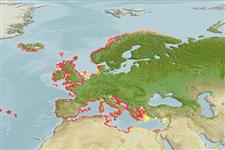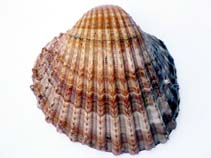Acanthocardia aculeata (Linnaeus, 1758)
Spiny cockle| Native range | All suitable habitat | Point map | Year 2050 |

|
| This map was computer-generated and has not yet been reviewed. |
| Acanthocardia aculeata AquaMaps Data sources: GBIF OBIS |
Classification / Names Common names | Synonyms | CoL | ITIS | WoRMS
Bivalvia | Cardiida | Cardiidae
Environment: milieu / climate zone / depth range / distribution range Ecology
Benthic; depth range 5 - 30 m (Ref. 2758). Temperate; 54°N - 30°N, 11°W - 36°E
Distribution Countries | FAO areas | Ecosystems | Occurrences | Introductions
Northeast Atlantic and the Mediterranean: from Celtic and Lusitanian provinces, extending into the Mediterranean.
Length at first maturity / Size / Weight / Age
Maturity: Lm ? range ? - ? cm Max length : 10.2 cm SHL male/unsexed; (Ref. 360); common length : 7.6 cm SHL male/unsexed; (Ref. 360)
Short description Morphology
Shell: solid, convex valves, equivalve and inequilateral, roughly oval in shape, uniformly deep yellow brown in color; sculpture consists of 20-22 well-developed ribs, with triangular spikes along the mid-line, in between are very marked concentric grooves; external ligament behind the umbones, hinge is heterodont; inside the valves are two identical scars (dimyarian and isomyarian) joined by a continuous pallial line, lacking a sinus. Body: foot is roughly cylindrical, well developed and used for leaping on the sand; distal extremity is bright red.
Minimum depth from Ref. 2703. Maximum depth from Ref. 106644. Found in an estuary (Ref. 122134). Coastal species (Ref. 112064), intertidal to the continental shelf (Ref. 105964). Lives in mud (Ref. 105964) and coarse sand (Ref. 106644).
Life cycle and mating behavior Maturity | Reproduction | Spawning | Eggs | Fecundity | Larvae
Members of the class Bivalvia are mostly gonochoric, some are protandric hermaphrodites. Life cycle: Embryos develop into free-swimming trocophore larvae, succeeded by the bivalve veliger, resembling a miniature clam.
Main reference
References | Coordinator | Collaborators
Gaspar, M.B., M.N. Santos and P. Vasconcelos. 2001. (Ref. 2758)
IUCN Red List Status (Ref. 130435)
CITES status (Ref. 108899)
Not Evaluated
CMS (Ref. 116361)
Not Evaluated
Threat to humans
Human uses
Fisheries: commercial
| FishSource |
Tools
More information
Internet sources
BHL | BOLD Systems | CISTI | DiscoverLife | FAO(Publication : search) | Fishipedia | GenBank (genome, nucleotide) | GloBI | Gomexsi | Google Books | Google Scholar | Google | PubMed | Tree of Life | Wikipedia (Go, Search) | Zoological Record
Estimates based on models
Preferred temperature
(Ref. 115969): 8.5 - 21.3, mean 17.8 (based on 884 cells).



